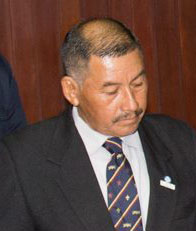Following a string of defeats in the courts and calls for the 2006 Amer-indian Act to be reformed to offer better protection for indigenous peoples, Minister of Indigenous Peoples’ Affairs Sydney Allicock says that he will move to have it amended soon.
“We can’t continue like this. It is not right to be treating the indigenous peoples in this way, who are the ones who have kept, I think, the ecosystems in place and this should be respected,” the minister told Stabroek News in an interview on Friday. He said the matter needs urgent attention and pointed to Section 53 of the Act in particular.
This section states that if the Guyana Geology and Mines Commission (GGMC) intends to issue a permit, concession, licence or other permission over or in any part of village lands; any land contiguous with village lands; or any rivers, creeks or waterways which pass through village lands or any lands contiguous with village land, the GGMC shall (I) first notify the village; and (II) satisfy itself that the impact of mining on the village will not be harmful.

It is clause (II) in particular, that is of concern. “This is not doing justice to the people because as long as it satisfies Geology and Mines, they go ahead and issue these things without the satisfaction of the people,” Allicock said. He declared that there should be proper discussion and agreements in the best interest of the people because they live there all the time, while miners only go to extract gold and leave behind a damaged environment.
“This needs immediate attention,” Allicock said. “We need to readjust this to bring more protection of the people.” He emphasised that this is harmful to the survival of the people and is also contrary to provisions in the Constitution.
He disclosed that the ministry is in consultation with various indigenous groups and other interested persons and they have been signaling the importance of getting the amendments done so that there is more protection of indigenous peoples, especially in the mining and logging areas. He said the ministry is currently awaiting other comments and recommendations for reforming the Act.
Allicock said he would prefer amendments rather than an entirely new Act because of the long process that a new Act would have to go through, which “would not give us the time to be able to rectify what is happening now.” He said there are several issues in communities that need to be dealt with immediately.
The minister highlighted the case of Tasserene and Kangaruma. Stabroek News reported on the plight of the Region Seven indigenous communities in September. The two communities had expressed fear of eviction after finding out that mining blocks had been given out over their land and the GGMC was continuing to give out lands for mining. The communities had received land titles before which covered these areas but they were taken back.
Allicock said the ministry had engaged the GGMC and it is worrying that they did not get the required outcome. He also emphasised that it is not that the ministry is not doing anything but the bureaucracy is a big challenge.
In an October 30, letter responding to the ministry, the GGMC said nothing prevents it from giving out mining permits. “There is no legal obstacle in the Mining Act or the Amerindian Act to the grant of permits or licences in areas applied for by the Amerindians under the Amerindian Act either as new titles or as extensions to existing titles except that by virtue of Section 53 of the Amerindian Act, GGMC is required to notify the village and satisfy itself that the impact of mining will not be harmful if it intends to issue a permit, concession or lease over or in any part of village lands, any lands contiguous with village lands or any rivers, creeks or waterways which pass through village lands or any lands contiguous with villages lands,” the agency wrote.
It also said that permits and licences granted in the areas applied for by the Amerindians under the Amerindian Act either as new titles or as extension to existing titles are lawful and binding. “If, and when Amerindian lands are lawfully extended to include the areas of such grants then the issue would be between the miners and the Amerindian communities to make the necessary arrangements as provided for by the Amerindian Act,” the GGMC wrote. It also provided documents pertaining to recent court cases which had gone in favour of miners.
“It’s indeed serious and we need to find a way out of this. It’s going on for too long,” Allicock declared. Recently, the village of Isseneru also complained that the GGMC had given permission for a miner to operate a river dredge close to the village’s residential area.
Meanwhile, Allicock said it is also crucial that the Indigenous Lands Commission be put in place and this will be among the issues discussed with Minster of Governance Raphael Trotman on Monday. He said that while he would not be able to give a definite timing, he hopes to begin the process of setting it up by the end of the year and hopefully, in the early part of next year, the commission should be in place. He said that they would like others to have an input so this will take a bit of time.





